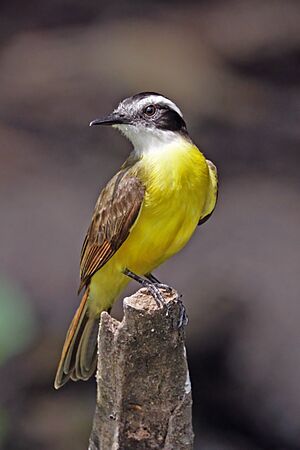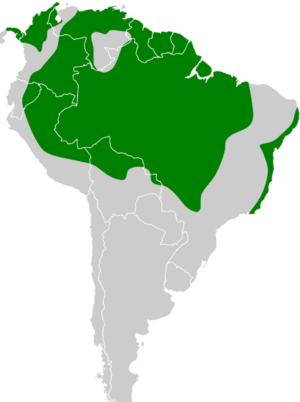Lesser kiskadee facts for kids
Quick facts for kids Lesser kiskadee |
|
|---|---|
 |
|
| Philohydor lictor panamense Chagres River, Panama |
|
| Conservation status | |
| Scientific classification | |
 |
|
| Synonyms | |
|
The lesser kiskadee (Philohydor lictor) is a small, active passerine bird. This means it's a type of songbird. It belongs to the Tyrannidae family, which are often called tyrant flycatchers. This bird is special because it's the only species in its group, called the genus Philohydor.
You can find the lesser kiskadee in many countries. These include Brazil, Bolivia, Argentina, Colombia, Ecuador, French Guiana, Guyana, Panama, Peru, Suriname, Trinidad, Guatemala, and Venezuela. It likes to live in warm, wet places. Its favorite homes are subtropical or tropical moist shrublands and swamps, usually close to water.
Meet the Lesser Kiskadee
The lesser kiskadee is a small bird, usually about 15 to 18 centimeters (6 to 7 inches) long. It weighs around 25 grams, which is about the same as a few quarters. These birds are often seen near rivers, lakes, and other wet areas. They are known for being lively and quick.
Its Interesting Name
The lesser kiskadee got its scientific name, Lanius lictor, from a German scientist named Hinrich Lichtenstein in 1823. Later, in 1984, an American bird expert, Wesley Edwin Lanyon, gave it the genus name Philohydor.
The name Philohydor comes from two old Greek words. Philos means "loving," and hudōr means "water." So, Philohydor means "water-loving." This makes sense because these birds love to be near water!
The second part of its name, lictor, comes from Latin. A lictor was a bodyguard for important officials in ancient Rome. They were known for carrying out sentences. Sometimes, the lesser kiskadee is grouped with the great kiskadee in the genus Pitangus.
Different Types of Lesser Kiskadees
Even though there's only one species of lesser kiskadee, there are two slightly different types, called subspecies:
- P. l. panamensis: This type lives in eastern Panama and the northern parts of Colombia. It was first described by scientists Outram Bangs and Thomas Edward Penard in 1918.
- P. l. lictor: This type is found from eastern Colombia, through the Guianas, south to Bolivia, and across eastern and central Brazil. This is the original type described by Hinrich Lichtenstein in 1823.


